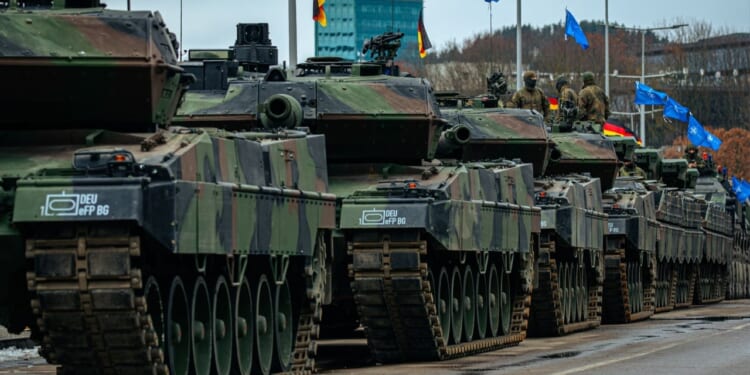At least forty German-produced Leopard 2 MBTs were lost as of last fall in the Russo-Ukrainian war, leading to Ukrainians, Germans, and tank enthusiasts alike to question its effectiveness.
Dozens of reports have suggested that Germany’s Leopard 2 is one of the best main battle tanks in the world today. The fighting in Ukraine may tell another story, however.
Even when the first models arrived nearly two years ago, the Leopard 2 wasn’t an unstoppable miracle weapon that turned the tide in the ongoing conflict. Then one was destroyed, followed by another and another. At least forty were lost as of last fall, part of the 20 percent of all Western-supplied MBTs.
This isn’t to say Western-made tanks are bad. Russia has also lost thousands of tanks, and Ukraine has turned into a graveyard of armor. If anything, man-portable anti-tank rocket launchers have proved far more effective than many analysts might have predicted, while few could have seen that drones could be the perfect tank killers.
Yet, the Leopard 2 tank stands out as one of the platforms that isn’t precisely delivering as promised, and Berlin is taking notes!
According to a report from the Telegraph, citing a recently published transcript of a conversation between the German defense attaché in Kyiv and about 200 Bundeswehr soldiers, even as Kyiv begged for Western-made tanks, the troops on the frontlines have lost their confidence in them.
“Some of the problems have to do with the way warfare itself is changing,” the paper of record reported. “Leopard 2s are vulnerable to drone strikes, like tanks in general, the transcript reads. However, the Leopard 2’s complicated design makes it difficult to repair on the battlefield, meaning that damaged Leopards must be sent to specialized repair crews in western Ukraine or even go to Poland to be fixed and maintained.”
Too Few Leopard 2s To Make A Difference in Ukraine
The idiom “too little, too late” could be applied to nearly all Western-supplied military hardware. Kyiv hasn’t received enough tanks, airplanes, or other equipment, and what has been sent has trickled mainly in.
“The main problem with Leopard 2s given to Ukraine is that there are too few. Suppose one or two have to be repaired. In that case, that’s a big part of what Ukraine has that’s suddenly out of commission for a while,” Sergej Sumlenny, managing director of the Berlin-based European Resilience Initiative Center, told The Telegraph.
Sumlenny added that the MBTs were also designed for a war where NATO forces would provide “good air support,” which is far from the case in Ukraine. Another problem the analyst added is that Germany hasn’t fought a major conflict since World War II.
“[The Leopard 2 was] designed by a generation of German manufacturers that hadn’t seen war and so tended to overcomplicate the system,” Sumlenny explained.
However, retired British Army officer Hamish de Bretton-Gordon suggested that the Leopard 2 had many of the same problems German tanks had in the Second World War. In a separate article for The Telegraph, Bretton-Gordon, who served in the Royal Tank Corps, noted Berlin’s past and current focus on over-engineering its military platforms.
“The Leopard 2 is a technical marvel, with echoes of the German Tiger tank in WW2: perhaps the most dangerous tank of the war. Leopard 2 has a complex fire control system, an outstandingly powerful MTU power pack (the engine), and an excellent 120mm smoothbore gun,” Bretton-Gordon wrote.
He went on to note that, like the infamous Tiger, the Leopard 2 is “tough to fix if damaged or broken down” and that, “worse still, like the Tiger of WW2, it is very few in numbers.”
The former British tank commander also stressed that the Leopard 2, much like the American M1 Abrams and British Challenger 2, were designed before the days of drones, which have caught the crews by surprise. He also acknowledged that since the Battle of Cambrai, just a year after the first British tanks rolled into action during the more significant Battle of the Somme, tank crews had already become fearful of ad hoc anti-tank weapons.
Tank crews must devise improvised solutions then and now, but the biggest issue is still one of numbers. He pointed out that the Allies had thousands of M3 Shermans, which proved more effective than the thousands of Tigers and Panthers the Germans fielded.
“We must avoid the same old German tank story from WW2. We must avoid the temptation to make our tanks too complex, too easy to hit, too difficult to maintain, and too few,” Bretton-Gordon concluded.
Ukrainians Having Problems with German Platforms
There are also reports that Ukrainian soldiers are “frustrated” by the performance of other German-supplied platforms—and it would be easy for those critical of the aid to immediately jump on social media and suggest that beggars can’t be choosy.
Yet, one needs to remember that honesty isn’t bad when it comes to matters of life and death. For one, the lessons from Ukraine will help German military planners respond accordingly.
As The Defense Post reported, some systems are underperforming. It noted, “One example is the Panzerhaubitze 2000 self-propelled howitzer, which, despite being described as an ’excellent’ system, allegedly suffers from ’high technical vulnerability’ that undermines its combat reliability.“
Likewise, Germany and other NATO countries provided Kyiv with 200 older Leopard 1A5 tanks. Still, unlike Russia, which sent its antiquated tanks like the T-62 and even older T-54/55 series to the frontlines, Ukrainian forces have employed them only as “improvised artillery.“
Finally, Ukrainian troops haven’t been critical of all of the hardware made in Germany and have touted the capabilities of several systems. The Gepard self-propelled anti-aircraft gun received high praise, and The Defense Post noted that Ukrainian soldiers described it as an “efficient and reliable” weapon.
About the Author: Peter Suciu
Peter Suciu is a Michigan-based writer. He has contributed to more than four dozen magazines, newspapers, and websites with over 3,200 published pieces over a twenty-year career in journalism. He regularly writes about military hardware, firearms history, cybersecurity, politics, and international affairs. Peter is also a Contributing Writer for Forbes and Clearance Jobs. You can follow him on Twitter: @PeterSuciu. You can email the author: [email protected].
Image: Shutterstock/ Arnoldas Vitkus.


















